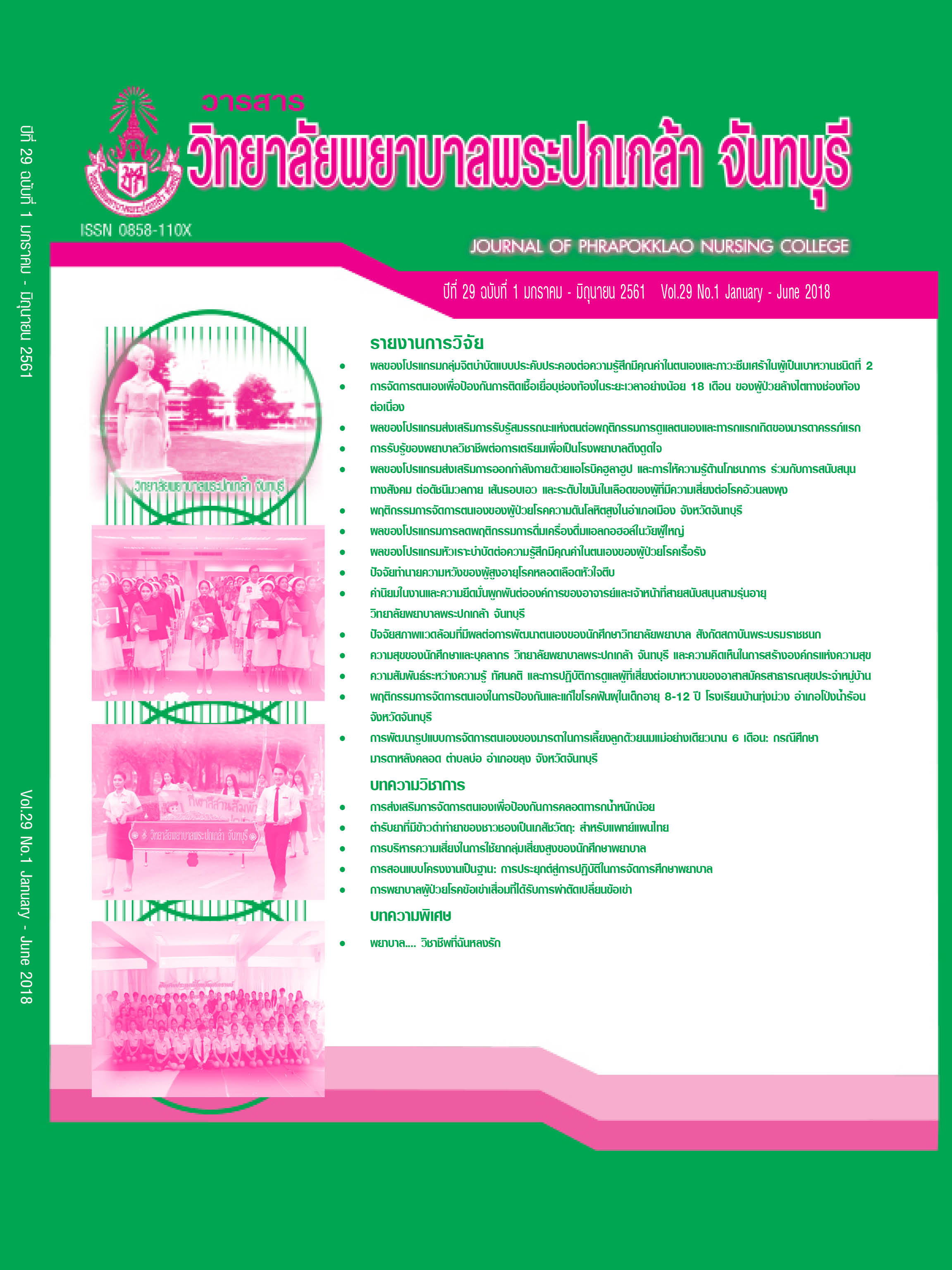Perception of Professional Nurses on Becoming a Magnet Hospital
Keywords:
Perception, Professional nurses, Preparation, Magnet hospitalAbstract
This qualitative descriptive research aimed to examine the perception of professional nurses on becoming a magnet hospital. The informants consisted of 16 professional nurses. The research instruments were composed of a recording form of demographic data, a semi-structured in-depth interview guide, a recording form of interview transcription, a tape-recorder, notebook, and pen. Data were collected from February to December, 2014 and were analyzed using frequency, percentage, mean, standard deviation, and content analysis.
The research results revealed that the perception of professional nurses on becoming a magnet hospital could be classified into 4 main categories:- 1) definition of magnet hospital: clients attracting, personnel attracting, and happy working of personnel; 2) participation in preparation for a magnet hospital: proud feeling and participation in various activities; 3) the effects of transition during a magnet hospital preparation: both positive and negative feeling; and 4) problems and obstacles in preparation for a magnet hospital: inadequate personnel number for workload, unclear and discontinuous communication, and elusiveness of a magnet hospital standard.
This research suggested that the administrators should pick an important data regarding a magnet hospital and present using interesting and clear techniques. Additionally, they should set policies to reduce professional nurse workload and recruit personnel appropriately.
References
จุรีรัตน์ สายสมบัติ, และฉัตรสุมน พฤฒิภิญโญ. (2555). ปัจจัยที่มีอิทธิพลต่อความสุขในการทำงานของพยาบาลวิชาชีพโรงพยาบาลมหาวิทยาลัยของรัฐ. วารสารพยาบาลศาสตร์ จุฬาลงกรณ์มหาวิทยาลัย, 24(3), 92-106.
ดวงรัตน์ วัฒนกิจไกรเลิศ, คัคนางค์ นาคสวัสดิ์, วรรณี สัตยวิวัฒน์, และชูชื่น ชีวพูนผล. (2553). ความเครียด ปัจจัยที่ทำให้เกิดความเครียด และการจัดการกับความเครียดในพยาบาล. วารสารพยาบาลศาสตร์, 28(1), 67-76.
ทัศนา บุญทอง. (2558). นโยบายระดับชาติเพื่อการพัฒนาวิชาชีพการพยาบาล. สืบค้น 4 เมษายน 2559, จาก http://www.tnc.or.th/files/2015/11/news39433/national_policy_for_nursing_development_30024.pdf
เพ็ญจันทร์ แสนประสาน, ยุวดี เกตสัมพันธ์, และวรรณี บุญช่วยเหลือ. (2551). Magnet hospital. ใน เอกสารการประชุมวิชาการ 9th HA National Forum Living Organization (องค์กรที่มีชีวิต). หน้า 1-10. กรุงเทพฯ: สถาบันพัฒนาและรับรองคุณภาพโรงพยาบาล.
พัชราวัลย์ เรืองศรีจันทร์, และศิริลักษณ์ ศุภปีติพร. (2554). ความเครียดของพยาบาล ความคิดเห็นต่อการเตรียมพร้อมเป็นโรงพยาบาลดึงดูดใจ และปัจจัยที่สัมพันธ์กับความเครียดของพยาบาลวิชาชีพโรงพยาบาลเอกชนระดับอินเตอร์เนชั่นแนล. วารสารสมาคมจิตแพทย์แห่งประเทศไทย, 56(4), 425-436.
วรนาถ วิมลเฉลา. (2543). คู่มือสอนแปล (พิมพ์ครั้งที่ 6). กรุงเทพฯ: โรงพิมพ์จุฬาลงกรณ์มหาวิทยาลัย.
วรรณดี สุทธินรากร. (2556). การวิจัยเชิงคุณภาพ: การวิจัยในกระบวนทัศน์ทางเลือก. กรุงเทพฯ: สยามปริทัศน์.
วราภรณ์ กุประดิษฐ์. (2555). การรับรู้ของพยาบาลวิชาชีพต่อการเป็นโรงพยาบาลที่ดึงดูดใจ กรณีศึกษาโรงพยาบาลที่ไม่มุ่งหวังผลกำไร. วารสารวิชาการมหาวิทยาลัยอีสเทิร์นเอเชีย, 6(2), 127-137.
ศิริพร แสงศรีจันทร์, และบุญใจ ศรีสถิตย์นรากูร. (2555). คุณภาพองค์การพยาบาลตามคุณลักษณะโรงพยาบาลดึงดูดใจ โรงพยาบาลเอกชน กรุงเทพมหานคร. วารสารพยาบาลศาสตร์ จุฬาลงกรณ์มหาวิทยาลัย, 24(1), 83-95.
ศูนย์วิจัยกสิกรไทย. (2552). โรงพยาบาลเอกชนปี’52: เร่งวิกฤตเศรษฐกิจ (ฉบับส่งสื่อมวลชน). ศูนย์วิจัยกสิกรไทย, 15(2397), 1-7.
สิริษา ทันเจริญ. (2554). ความสัมพันธ์ระหว่างสถานภาพโรงพยาบาล การเป็นโรงพยาบาลดึงดูดใจกับความยึดมั่นผูกพันต่อองค์การของพยาบาลวิชาชีพ โรงพยาบาลมหาวิทยาลัย (วิทยานิพนธ์ปริญญามหาบัณฑิต). กรุงเทพฯ: จุฬาลงกรณ์มหาวิทยาลัย.
สุมาลี อยู่ผ่อง, และบุญทิพย์ สิริธรังศรี. (2557). ปัจจัยการคงอยู่ในงานของพยาบาลวิชาชีพงานการพยาบาลศัลยศาสตร์ โรงพยาบาลมหาวิทยาลัยแห่งหนึ่งในกรุงเทพมหานคร. ใน เอกสารการประชุมเสนอผลงานวิจัยระดับบัณฑิตศึกษา มหาวิทยาลัยสุโขทัยธรรมาธิราช ครั้งที่ 4. หน้า 1-13. นนทบุรี: มหาวิทยาลัยสุโขทัยธรรมาธิราช.
สุภลักษณ์ ธานีรัตน์, กมลรัตน์ เทอร์เนอร์, และสุจิรา วิเชียรรัตน์. (2550). การติดตามสมรรถนะทางการพยาบาลของผู้สำเร็จการศึกษาปีการศึกษา 2547 จากวิทยาลัยพยาบาลบรมราชชนนี จังหวัดนนทบุรี (รายงานผลการวิจัย). วิทยาลัยพยาบาลบรมราชชนนี จังหวัดนนทบุรี.
สุภางค์ จันทวานิช. (2559). การวิเคราะห์ข้อมูลในการวิจัยเชิงคุณภาพ (พิมพ์ครั้งที่ 23). กรุงเทพฯ: สำนักพิมพ์แห่งจุฬาลงกรณ์มหาวิทยาลัย.
สุภาณี คงชุม. (2550). การศึกษาลักษณะโรงพยาบาลที่ดึงดูดใจพยาบาลวิชาชีพ (วิทยานิพนธ์ปริญญามหาบัณฑิต). กรุงเทพฯ: จุฬาลงกรณ์มหาวิทยาลัย.
อรุณรัตน์ คันธา, เดช เกตุฉ่ำ, กฤษดา แสวงดี, และตวงทิพย์ ธีระวิทย์. (2556). การย้ายงานของพยาบาลวิชาชีพในประเทศไทย. วารสารสภาการพยาบาล, 28(3), 19-31.
อุษณี ณ ตะกั่วทุ่ง. (2551). การศึกษาความเป็นโรงพยาบาลดึงดูดใจตามการรับรู้ของพยาบาลวิชาชีพ โรงพยาบาลศูนย์ กระทรวงสาธารณสุข (วิทยานิพนธ์ปริญญามหาบัณฑิต). กรุงเทพฯ: จุฬาลงกรณ์มหาวิทยาลัย.
American Nurses Credentialing Center (ANCC). (2014). 2014 Magnet application manual. Silver Spring: Author.
Brady-Schwartz, D. C. (2005). Further evidence on the magnet recognition program: Implications for nursing leaders. Journal of Nursing Administration, 35(9), 397-403.
Cox, K. S., Carroll, C. S., & Sexton, K. (2005). Achieving magnet status: Demonstrating nursing excellence. Retrieved April 5, 2015, from http://findarticles.com
Deming, W. E. (1986). Out of crisis. Boston: The Massachusetts Institute of Technology Center for Advance Engineering Study.
Hayhurst, A., Saylor, C., & Stuenkel, D. (2005). Work environmental factors and retention of nurses. Journal of Nursing Care Quality, 20(3), 283-288.
Lacey, S. R., Cox, K. S., Lorfing, K. C., Teasley, S. L., Carroll, C. A., & Sexton, K. (2007). Nursing support, workload, and intent to stay in Magnet, Magnet-aspiring, and non-Magnet hospitals. The Journal of Nursing Administration, 37(4), 199-205.
Pierson, P., Miller, J., & Moore, K. (2007). Engaging staff in the magnet journey: The key of communication. MEDSURG Nursing, 16(1), 23-28.
Romano, M. A. (2002). Strong attraction: As hospital seek “Magnet” status to retain nurses and improve care, some see the program as little more than a pricey gimmick. Modern Healthcare, 32(50), 28-38.
Steven, T. H. (2009). Nursing turnover: Costs, causes, & solutions success factors for healthcare. Retrieved June 2, 2017, from http://www.nmlegis.gov/lcs/handouts
Downloads
Published
How to Cite
Issue
Section
License
Copyright (c) 2018 Journal of Phrapokklao Nursing College

This work is licensed under a Creative Commons Attribution-NonCommercial-NoDerivatives 4.0 International License.
เนื้อความ ข้อมูล และรายการอ้างอิงที่ผู้เขียนใช้ในการเขียนบทความเพื่อลงตีพิมพ์ในวารสารวิทยาลัยพยาบาลพระปกเกล้า จันทบุรี ถือเป็นความคิดเห็นและความรับผิดชอบของผู้เขียน คณะผู้จัดทำวารสารไม่จำเป็นต้องเห็นพ้องด้วยหรือร่วมรับผิดชอบ
บทความที่ได้รับการลงตีพิมพ์ในวารสารวิทยาลัยพยาบาลพระปกเกล้า จันทบุรี ถือเป็นลิขสิทธิ์ของวารสารวิทยาลัยพยาบาลพระปกเกล้า จันทบุรี หากหน่วยงานหรือบุคคลใดต้องการนำส่วนหนึ่งหรือทั้งหมดของบทความไปเผยแพร่ต่อเพื่อวัตถุประสงค์ใด ๆ จะต้องได้รับอนุญาตจากบรรณาธิการวารสารก่อน



